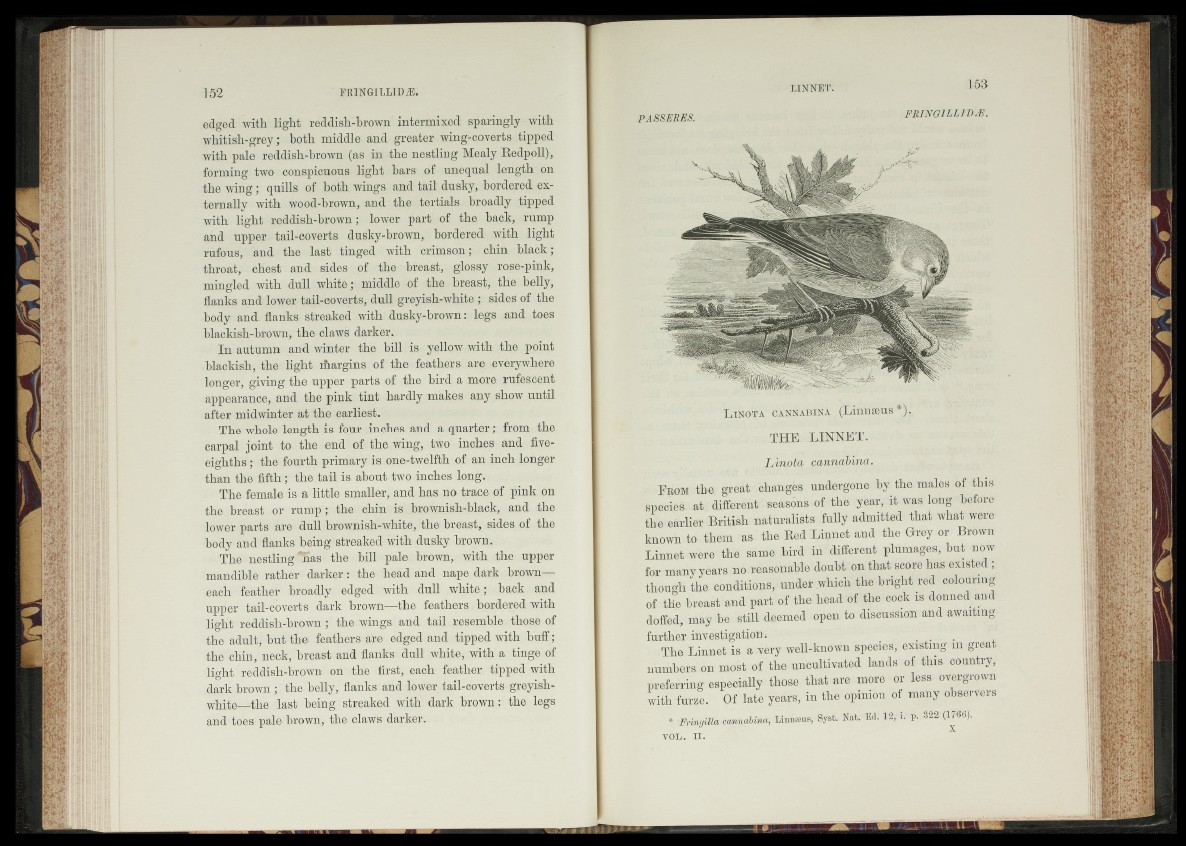
edged with light reddish-brown intermixed sparingly with
whitish-grey; both middle and greater wing-coverts tipped
with pale reddish-brown (as in the nestling Mealy Redpoll),
forming two conspicuous light bars of unequal length on
the wing; quills of both wings and tail dusky, bordered externally
with wood-brown, and the tertials broadly tipped
with light reddish-brown; lower part of the back, rump
and upper tail-coverts dusky-brown, bordered with light
rufous, and the last tinged with crimson; chin black;
throat, chest and sides of the breast, glossy rose-pink,
mingled with dull white; middle of the breast, the belly,
flanks and lower tail-coverts, dull greyish-white ; sides of the
body and. flanks streaked with dusky-brown: legs and toes
blackish-brown, the claws darker.
In autumn and winter the bill is yellow with the point
blackish, the light ihargins of the feathers are everywhere
longer, giving the upper parts of the bird a more rufeseent
appearance, and the pink tint hardly makes any show until
after midwinter at the earliest.
The whole length is four inches and a quarter; from the
carpal joint to the end of the wing, two inches and five-
eighths ; the fourth primary is one-twelfth of an inch longer
than the fifth; the tail is about two inches long.
The female is a little smaller, and has no trace of pink on
the breast or rump; the chin is brownish-black, and the
lower parts are dull brownish-white, the breast, sides of the
body and flanks being streaked with dusky brown.
The nestling Taas the bill pale brown, with the upper
mandible rather darker : the head and nape dark brown—
each feather broadly edged with dull white; back and
upper tail-coverts dark brown—the feathers bordered with
light reddish-brown ; the wings and tail resemble those of
the adult, but the feathers are edged and tipped with buff;
the chin, neck, breast and flanks dull white, with a tinge of
light reddish-brown on the first, each feather tipped with
dark brown ; the belly, flanks and lower tail-coverts greyish-
white—the last being streaked with dark brown: the legs
and toes pale brown, the claws darker.
PASSE RES. FRJNG1LLID/E.
LlNOTA CANNABINA (L ilin g eU S * ) .
THE LINNET.
Llnota cannabina.
F rom tbe great changes undergone by the males of this
species at different seasons of the year, it was long before
the earlier British naturalists fully admitted that what were
known to them as the Red Linnet and the Grey or Brown
Linnet were the same bird in different plumages, but now
for many years no reasonable doubt on that score has existed,
though the conditions, under which the bright red colouring
of the breast and part of the head of the cock is donned and
doffed, may be still deemed open to discussion and awaiting
further investigation. _ . .
The Linnet is a very well-known species, existing m grea
numbers on most of the uncultivated lands of this country,
preferring especially those that are more or less overgrown
with furze. Of late years, in the opinion of many observers
* Fnngilla cannabina, Linnaaus, Syst. Nat. Ed. 12, i. p. 322 (1766).
VOL. II.